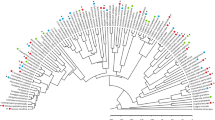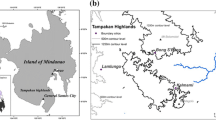Abstract
The floristic diversity of Mexican tropical deciduous forests (TDF) is of critical importance given the high species richness (alpha diversity), species turnover (beta diversity), and the intense deforestation rates. Currently, most TDF landscapes are mosaics of agricultural land, secondary vegetation, and patches of relatively undisturbed primary vegetation. Here we illustrate how both primary forest remnants and secondary vegetation patches contribute to the floristic diversity of TDF in a landscape of volcanic origin in central Veracruz, Mexico. Our objectives were to assess sampling efficiency and inventory completeness, to compare mean and cumulative species richness between primary forest and secondary vegetation sites, and to analyze beta diversity between vegetation types. In an area of 12,300 m² we recorded 105 families, 390 genera, and 682 species. Species inventories for both vegetation types were about 80% complete. Secondary vegetation is more alpha diverse than primary forest, both in terms of cumulative and mean species richness. We found a remarkably high beta diversity between vegetation types (75% of complementarity, 91.60% of mean dissimilarity). We also identified the species that contribute the most to similarity within vegetation types and to dissimilarity between vegetation types. Our results support the idea that assessing biodiversity on the landscape scale is an appropriate way to ascertain the impact of human activities. For this land mosaic, conservation of the flora would not be possible by focusing solely on primary forest remnants. We propose the implementation of a network of small conservation areas with a flexible structure, following the “archipelago reserve” model.





Similar content being viewed by others
References
Begon M, Townsend CR, Harper JL (2006) Ecology: from individuals to ecosystems, 4th edn. Blackwell Publishing, London
Brooks TM, Mittermeier RA, da Fonseca GAB, Gerlach J, Hoffmann M, Lamoreux JF, Mittermeier CG, Pilgrim JD, Rodrigues ASL (2006) Global biodiversity conservation priorities. Science 313:58–61
Chazdon RL, Colwell RK, Denslow JS, Guariguata MR (1998) Statistical methods for estimating species richness of woody regeneration in primary and secondary rain forests of northeastern Costa Rica. In: Dallmeier F, Comiskey JA (eds) Forest biodiversity research, monitoring and modelling: conceptual background and old world case studies. The Parthenon Publishing Group, Paris, pp 285–309
Chee YE (2004) An ecological perspective on the valuation of ecosystem services. Biol Conserv 120:549–565
Chiarucci A, Maccherini S, De Dominicis V (2001) Evaluation and monitoring of the flora in a nature reserve by estimation methods. Biol Conserv 101:305–314
Clarke KR, Warwick M (1994) Change in marine communities: an approach to statistical analysis and interpretation. Plymouth Marine Laboratory, Plymouth
Clarke KR, Gorley RN (2001) PRIMER v5: user manual/tutorial. Plymouth Marine Laboratory, Plymouth
Colwell RK (2005) EstimateS: statistical estimation of species richness and shared species from samples. Version 7.5. Available on line at: http://viceroy.eeb.uconn.edu/estimates. University of Connecticut, Storrs
Colwell RK, Coddington JA (1994) Estimating terrestrial biodiversity through extrapolation. Phil Trans R Soc B 345:101–118
Colwell RK, Mao CX, Chang J (2004) Interpolating, extrapolating, and comparing incidence-based species accumulation curves. Ecology 85:2717–2727
Connell JH (1978) Diversity in tropical rainforests and coral reefs. Science 199:1302–1310
DeAngelis DL, Waterhouse JC (1987) Equilibrium and non-equilibrium concepts in ecological models. Ecol Monogr 57:1–21
Díaz-Francés E, Soberón J (2005) Statistical estimation and model selection of species-accumulation functions. Conserv Biol 19:569–573
Edwards PJ, Abivardi C (1998) The value of biodiversity: where ecology and economy blend. Biol Conserv 83:239–246
García E (1981) Modificaciones al sistema de clasificación climática de Köppen. Indianápolis 30, México
Gentry AH (1982) Neotropical floristic diversity. Ann Mo Bot Gard 69:557–593
Gerhardt K (1993) Tree seedling development in tropical dry abandoned pasture and secondary forest in Costa Rica. J Veg Sci 4:95–102
Gotelli NJ, Colwell RK (2001) Quantifying biodiversity: procedures and pitfalls in the measurement and comparison of species richness. Ecol Lett 4:397–391
Gordon JE, Hawthorne WD, Reyes-García A, Sandoval G, Barrance AJ (2004) Assessing landscapes: a case study of tree and shrub diversity in the seasonally dry tropical forests of Oaxaca, Mexico and southern Honduras. Biol Conserv 117:429–442
Gove AD, Majer JD, Rico-Gray V (2005) Methods for conservation outside of formal reserve systems: the case of ants in the seasonally dry tropics of Veracruz, Mexico. Biol Conserv 126:328–338
Halffter G (1998) A strategy for measuring landscape biodiversity. Biol Int 36:3–17
Halffter G (2005) Towards a culture of biodiversity conservation. Acta Zool Mex (n.s.) 21:133–153
Halffter G, Moreno CE (2005) Significado biológico de las diversidades alfa, beta y gamma. In: Halffter G, Soberón J, Koleff P, Melic A (eds) Sobre Diversidad Biológica: el Significado de las Diversidades Alfa, Beta y Gamma. M3M: Monografías Tercer Milenio, vol 4. Sociedad Entomológica Aragonesa, Zaragoza, pp 5–18
Hernandez-Stefanoni JL (2006) The role of landscape patterns of habitat types on plant species diversity of a tropical forest in Mexico. Biodivers Conserv 15:1441–1457
Hernandez-Stefanoni JL, Bello-Pineda J, Valdes-Valadez G (2006) Comparing the use of indigenous knowledge with classification and ordination techniques for assessing the species composition and structure of vegetation in a tropical forest. Environ Manage 37:686–702
Holling CS (1986) The resilience of terrestrial ecosystems: local surprise and global change. In: Williams CC, Munn RE (eds) Sustainable development of the biosphere. IISASA. Cambridge University Press, Cambridge, pp 289–317
Janzen D (1988) Tropical dry forest: the most endangered major tropical ecosystems. In: Wilson EO (ed) Biodiversity. National Academy Press, Washington DC, pp 130–137
Khurana E, Singh JS (2001) Ecology of seed and seedling growth for conservation and restoration of tropical dry forest: a review. Environ Conserv 28:39–52
Laurance WF (1999) Reflections on the tropical deforestation crisis. Biol Conserv 91:109–117
Lerdau M, Whitbeck J, Holbrook NM (1991) Tropical deciduous forest: death of a biome. Trends Ecol Evol 6:201–202
Li J, Ren Z, Zhou Z (2006) Ecosystem services and their values: a case study in the Qinba mountains of China. Ecol Res 21:597–604
Lott EJ (1987) Floristic diversity and structure of upland and arroyo forest of coastal Jalisco. Biotropica 19:228–235
Medail F, Verlaque R (1997) Ecological characteristics and rarity of endemic plants from southeast France and Corsica: implications for biodiversity conservation. Biol Conserv 80:269–281
Miranda F, Hernández XE (1963) Los tipos de vegetación de México y su clasificación. Bol Soc Bot Méx 28:29–179
Mooney HA, Bullock SH, Medina E (1995) Introduction. In: Bullock SH, Mooney HA, Medina E (eds) Seasonally dry tropical forests. Cambridge University Press, Cambridge, pp 1–7
Murphy PG, Lugo AE (1986) Ecology of tropical dry forest. Ann Rev Ecol Syst 17:67–88
Negendank JFW, Emmermann R, Krawczyk R, Mooser F, Tobschall H, Werle D (1985) Geological and geochemical investigations on the eastern trans Mexican volcanic belt. Geofísica Internacional 24:477–575
Ortega OR (1981) Vegetación y flora de una corriente de lava (malpaís) al noreste del Cofre de Perote, Ver. Biotica 6:57–97
Ricker M, Ramírez-Krauss I, Ibarra-Manríquez G, Martínez E, Ramos CH, González-Medellín G, Gómez-Rodríguez G, Palacio-Prieto JL, Hernández HM (2007) Optimizing conservation of forest diversity: a country-wide approach in Mexico. Biodivers Conserv 16:1927–1957
Rzedowski J (1978) Vegetación de México. Limusa, México
Sarukhán J (1998) Los tipos de vegetación arbórea de la zona cálido húmeda de México. In: Pennington TD, Sarukhán J (eds) Árboles Tropicales de México. Universidad Nacional Autónoma de México and Fondo de Cultura Económica, México D.F., pp 13–65
Soberón J, Llorente J (1993) The use of species accumulation functions for the prediction of species richness. Conserv Biol 7:480–488
Steininger MK, Tucker CJ, Ersts P, Killeen TJ, Villegas Z, Hecht SB (2001) Clearance and fragmentation of tropical deciduous forest in the Tierras Bajas, Santa Cruz, Bolivia. Conserv Biol 15:856–866
Tilman D, Pacala S (1993) The maintenance of species richness in plant communities. In: Ricklefs R, Schluter D (eds) Species diversity in ecological communities: historical and geographical perspectives. The University of Chicago Press, Chicago, pp 13–25
Toledo VM (1982) Pleistocene changes of vegetation in tropical Mexico. In: Prance GT (ed) Biological diversification in the tropics. Columbia University Press, New York, USA, pp 93–111
Trejo I (2005) Análisis de la diversidad de la selva baja caducifolia en México. In: Halffter G, Soberón J, Koleff P, Melic A (eds) Sobre Diversidad Biológica: el Significado de las Diversidades Alfa, Beta y Gamma. M3M: Monografías Tercer Milenio, vol 4. Sociedad Entomológica Aragonesa, Zaragoza, pp 111–122
Trejo I, Dirzo R (2000) Deforestation of seasonally dry tropical forest: a national and local analysis in Mexico. Biol Conserv 94:133–142
Trejo I, Dirzo R (2002) Floristic diversity of Mexican seasonally dry tropical forests. Biodivers Conserv 11:2063–2048
Vieira DLM, Scariot A (2006) Principles of natural regeneration of tropical dry forests for restoration. Restor Ecol 14:11–20
Williams-Linera G (2002) Tree species richness complementarity, disturbance and fragmentation in a Mexican tropical montane cloud forest. Biodivers Conserv 11:1825–1843
Acknowledgements
We would like to thank the following people for their support: Pablo O. Aguilar and Lamberto Aragón Axomulco for technical support with computer programming, Sergio Avendaño Reyes, Israel Acosta Rosado and Ma. Elena Medina Abreo for technical support in field sampling. We thank José Ramón Verdú (CIBIO, Universidad de Alicante) for his constructive revision of the manuscript, and Bianca Delfosse for her careful correction of the English. This research was financed by CONABIO (Project L-228), CONACYT (153088), and the Department of Biodiversity and Systematics (902-14) at the Instituto de Ecología, A.C.
Author information
Authors and Affiliations
Corresponding author
Rights and permissions
About this article
Cite this article
Castillo-Campos, G., Halffter, G. & Moreno, C.E. Primary and secondary vegetation patches as contributors to floristic diversity in a tropical deciduous forest landscape. Biodivers Conserv 17, 1701–1714 (2008). https://doi.org/10.1007/s10531-008-9375-7
Received:
Accepted:
Published:
Issue Date:
DOI: https://doi.org/10.1007/s10531-008-9375-7




